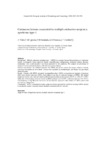Mostrar o rexistro simple do ítem
Cutaneous lesions associated to multiple endocrine neoplasia syndrome type 1
| dc.contributor.author | Vidal, A. | |
| dc.contributor.author | Iglesias, M.J. | |
| dc.contributor.author | Fernández, B. | |
| dc.contributor.author | Fonseca, E. | |
| dc.contributor.author | Cordido, Fernando | |
| dc.date.accessioned | 2018-05-15T07:37:40Z | |
| dc.date.available | 2018-05-15T07:37:40Z | |
| dc.date.issued | 2008 | |
| dc.identifier.citation | Vidal A, Iglesias MJ, Fernández B, Fonseca E, Cordido F. Cutaneous lesions associated to multiple endocrine neoplasia syndrome type 1. J Eur Acad Dermatol Venereol. 2008;22(7):835-838 | es_ES |
| dc.identifier.issn | 1468-3083 | |
| dc.identifier.issn | 0926-9959 | |
| dc.identifier.uri | http://hdl.handle.net/2183/20703 | |
| dc.description | Original article | es_ES |
| dc.description.abstract | [Abstract] Background Multiple endocrine neoplasia type 1 (MEN1) is a genetic disease that predisposes to endocrine tumour development. Some cutaneous lesions (angiofibromas, collagenomas, melanosis guttaca, lipomas, melanomas, ‘cafe au lait macules’) have been associated to this syndrome. We compare the prevalence of cutaneous lesion in affected patients with their non‐carrier relatives. Patients and method We studied 9 patients with MEN1 and 20 non‐carrier, first‐degree relatives. Genetic screening was realized in all of them. Patients were examined by dermatologist, and biopsy was performed when necessary. Results Patients with MEN1 presented hyperparathyroidism (100%), neuroendocrine tumours of pancreas (66%) and pituitary adenomas (44%); their relatives were free of endocrine features of MEN1. The studied cutaneous lesions were more prevalent in affected patients than in non‐carriers (55.5% vs. 25%; P = 0.029). Odds ratio of developing cutaneous lesions in MEN1 patients was 6.6 (95% confidence interval, 1.09–40.43). The frequency of angiofibromas was lower (22.2%) than the reported in other studies (43–88%), and we did not find any collagenoma. Conclusions MEN1 is associated to some cutaneous lesions and could be useful for detecting MEN1 carriers in an affected family. Cutaneous lesions should be assessed in MEN1 patients. | es_ES |
| dc.description.sponsorship | Instituto de Salud Carlos III; FIS PI051024 | es_ES |
| dc.description.sponsorship | Xunta de Galicia; PGIDT05PXIC91605PN | es_ES |
| dc.language.iso | eng | es_ES |
| dc.publisher | Wiley | es_ES |
| dc.relation.uri | https://doi.org/10.1111/j.1468-3083.2008.02578.x | es_ES |
| dc.rights | This is the peer reviewed version of the article which has been published in final form at Wiley Online Library. This article may be used for non-commercial purposes in accordance with Wiley Terms and Conditions for self-archiving. | es_ES |
| dc.subject | Angiofibroma | es_ES |
| dc.subject | Collagenoma | es_ES |
| dc.subject | Lipoma | es_ES |
| dc.subject | Multiple endocrine neoplasia type 1 | es_ES |
| dc.title | Cutaneous lesions associated to multiple endocrine neoplasia syndrome type 1 | es_ES |
| dc.type | info:eu-repo/semantics/article | es_ES |
| dc.rights.access | info:eu-repo/semantics/openAccess | es_ES |
| UDC.journalTitle | Journal of the European Academy of Dermatology and Venereology | es_ES |
| UDC.volume | 22 | es_ES |
| UDC.issue | 7 | es_ES |
| UDC.startPage | 835 | es_ES |
| UDC.endPage | 838 | es_ES |
Ficheiros no ítem
Este ítem aparece na(s) seguinte(s) colección(s)
-
GI-FENM - Artigos [106]






